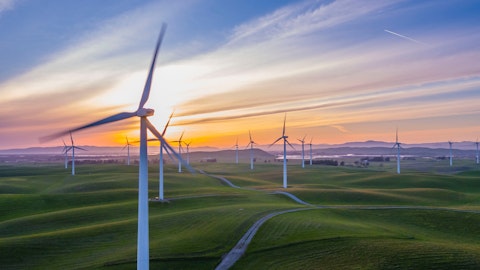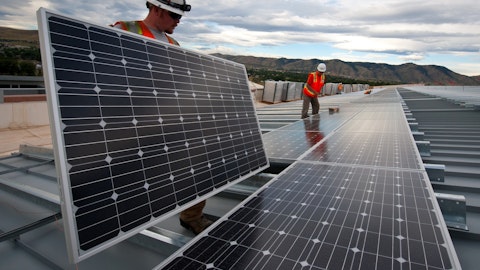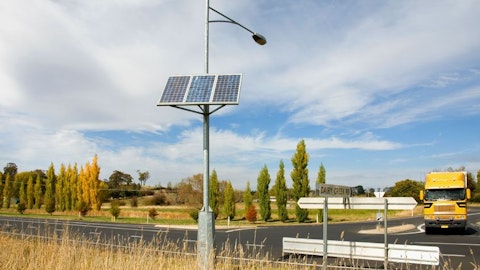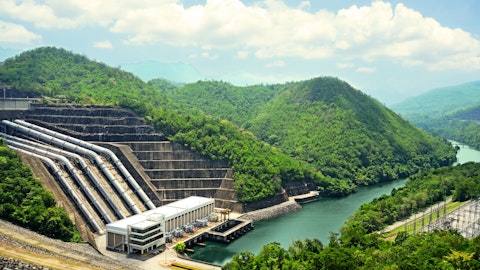Atlantica Sustainable Infrastructure plc (NASDAQ:AY) Q4 2022 Earnings Call Transcript March 1, 2023
Operator: Welcome to Atlantica’s Full Year 2022 Financial Results Conference Call. Atlantica is a Sustainable Infrastructure company. Just a reminder that this call is being webcast live on the Internet and a replay of this call will be available on Atlantica’s corporate website. Atlantica will be making forward-looking statements during this call based on the current expectations and assumptions, which are subject to risks and uncertainties. Actual results could differ materially from our forward-looking statements if any of our key assumptions are incorrect or because of other factors discussed in today’s earnings presentation or because of other factors discussed, including the Risk Factors section of the accompanying presentation and in our latest reports and filings with the Securities and Exchange Commission, all of which can be found on our website.
Atlantica does not undertake any duty to update any forward-looking statements. Joining us for today’s conference call are Atlantica’s CEO, Santiago Seage; and CFO, Francisco Martinez-Davis. As usual, at the end of the conference call, we will open the lines for a Q&A session. I will now pass you over to Mr. Seage. Please, sir, go ahead.
Santiago Seage: Thank you very much. Good morning. And thank you everybody for joining us for our 2022 conference call. I will start with a few key messages. In 2022, revenue and adjusted EBITDA increased by 2.9% and 1.5%, respectively, on a comparable basis. At the same time, cash available for distribution increased by 5.5% year-over-year, reaching $238 million. Net cash provided by operating activities in 2022 was $586 million, a 16% increase compared with 2021. With those results, we are initiating our 2023 CAFD guidance in the range of $235 million to $260 million. And in terms of investment growth, we have already committed or we have earmarked investments representing for 2023 between $165 million and $185 million. With those key messages in mind, I will now turn the call to Francisco, who will take you through the results. Francisco, whenever you wanted to?
Francisco Martinez-Davis: Thank you very much, Santiago, and good morning to everyone. Please turn to slide number five, where I will present our key financials for full year 2022. Revenue reached $1,102 million, which represents a 2.9% growth on a comparable basis, excluding the effects of the non-recurrent solar project that we discussed last year and foreign exchange. Adjusted EBITDA amounted to $797 million, representing an increase of 1.5% on the same comparable basis. Regarding cash available for distribution, we generated $238 million for the full year, an increase of 5.5% year-over-year. On the following slide number six, you can see our performance by geography and business sector. In North America, revenue increased by 2% to $405 million in the full year 2022, mainly due to the contribution from the recently acquired assets.
In South America, revenue increased by 7% compared to 2021, up to $166 million and EBITDA increased 6%, up to $126 million. The increase was mainly due to the assets acquired during the period and to inflation mechanisms. Revenue and EBITDA in the EMEA region, excluding the foreign exchange impact in the non-recurrent effect mentioned previously, both increased by 2% in 2022. This was mostly due to higher production and inflation indexation in Coso , as well as higher electricity prices in Spain. Looking below at the results by business sector, we can see similar effects. Now let’s please turn to slide number seven, where we will review our operational performance. Electricity produced by renewable assets reached 5,319 gigawatt hours in the full year 2022, an increase of 14% versus the same period of 2021.
The increase was largely due to the contribution of assets recently acquired. Looking at our availability based contracts, once again, ACT continues to show solid performance. In water, availability in 2022 was higher than 2021, with very good performance in all the assets. And our Transmission Lines continue to achieve high availability levels. Now let’s move to slide number eight to walk you through our cash flow for the full year 2022. Our operating cash flow reached $586 million, a strong 16% increase compared to the full year 2021. This increase was mainly due to an improvement in changes in working capital of $82 million, mostly a result of better collections in ACT and better collections in Spain. Investing cash flow for the full year 2022 mainly includes the investments in new assets and the distributions received from method — from entities under the equity method.
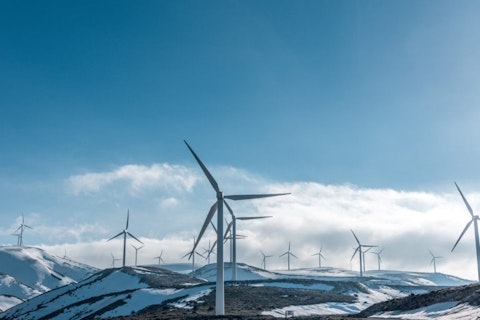
Photo by Jason Blackeye on Unsplash
Financing cash flow was $535 million and it mainly includes the scheduled principal repayment of our project finance agreements for $426 million and dividends paid to shareholders and non-controlling interest for $242 million. On the next slide number nine, we would like to review our net debt position, which has decreased significantly compared to 2021 year end. Net debt as of December 31, 2022, was $4,013 million, a decrease of approximately $500 million versus December 31, 2021. In addition, we closed the full year 2022 with a net corporate debt of $956 million. With this, our net corporate debt to CAFD pre-corporate debt service ratio stood at 3.4 times. Moving on to the next slide, slide number 10. In 2022, we have also made good progress on the ESG front and our effort continues to be recognized.
In November 2022, Atlantica was ranked number one globally on the GRESB’s Infrastructure Public Disclosure Rating. In December 2022, we were included for the second consecutive year in CDP’s A List, achieving the highest core environmental transparency and action in relation to climate change. In January 2023, we were ranked for the third consecutive year by Global 100 among the World’s 100 Most Sustainable Corporations. Also, in January 2023, Atlantica was included for the third consecutive year in the Bloomberg Gender Equality Index. And finally, in February 2023, Atlantica was included for the second consecutive year in the S&P Global Sustainability Yearbook. Now, with this, I will turn the call back over to Santiago.
Santiago Seage: If we talk now about growth and investments, we can see on page 12 that we have already committed or earmarked equity investments for 2023 in the range between $165 million and $185 million. These investments include the construction of our first battery storage plant located inside our Coso geothermal plant in California, which we recently announced, includes as well several PV assets in our key geographies, as well as the expansion of two of our transmission lines. Additionally, we include other investments where you will find storage projects in several locations plus our first hydrogen project. This is a 10-megawatt PV facility with hydrogen manufacturing facility as well that recently won a grant in Europe, in Spain, specifically, and we expect this to be our first hydrogen project.
If we look on page 13 at our pipeline beyond 2023, what you can see there is following the discussions we have been having over the last quarters, regarding the fact that Atlantica is — we expect Atlantica to grow more through development and construction of assets we have developed. You will see that we currently have a pipeline of assets under development of approximately 2 gigawatts of renewable energy and over 5 gigawatts hours of storage. This includes both repowering or expansion opportunities within the existing portfolio, as well as greenfield development done by Atlantica or in collaboration with partners in the different geographies. As you will see, our pipeline consists mostly of PV, storage and wind projects, and is mainly focused on North America, intending to leverage the IRA.
And finally, if we look at the last page and our 2023 target guidance, we expect CAFD to be in the range of $235 million to $260 million and we expect adjusted EBITDA to be in the range of $790 million to $850 million. With that, I conclude today’s presentation. Thank you very much for joining us, and Operator, we will now open the lines for questions, please.
See also 16 High Growth Non-Tech Stocks That Are Profitable and 11 High Growth UK Stocks to Buy.
Q&A Session
Follow Atlantica Sustainable Infrastructure Plc (NASDAQ:AY)
Follow Atlantica Sustainable Infrastructure Plc (NASDAQ:AY)
Operator: Thank you. We will have our first question on the line from David Quezada of Raymond James. Your line is open.
David Quezada: Good morning. Thanks. Hi, everyone. Maybe just — I certainly appreciate the new disclosures on the development pipeline. Santiago, I was wondering if there’s any color you can share just in terms of the pace of how — where these — how these projects will be developed and any key milestones you can share on projects that are in that development pipeline?
Santiago Seage: Sure, and good morning, David. So as you will see in the disclosure, Atlantica has been building over the years that pipeline and is working on continuing to build that pipeline. We believe that for a company like us, it makes sense to grow combining development of projects, in many cases with partners together with acquisitions. And regarding our current pipeline, you have it broken down between shorter term projects, projects where we expect to reach ready to build this year or next year, and projects that are in an earlier development phase. As you will see there, our development pipeline is fairly young. So a significant percentage of those projects are still in, what I would call, early stages. But we do believe that over the foreseeable future, we are going to be able to feed ourselves if you want to build these projects and they will represent a significant percentage of the investments we will be doing every year.
We won’t be the only source of growth, but we expect to be a significant part of our growth going forward.
David Quezada: Excellent. Thanks for that. And maybe just kind of a follow-up here or thoughts around your funding plan and asset recycling, do you see a business model eventually trending towards a company that is maybe selling operational assets or a stake in operational assets and even that to fund an ongoing development pipeline?
Santiago Seage: So we will, obviously, consider all options when deciding how to finance growth, and obviously, the conditions are the right ones. What you are mentioning could be one of the ways to finance the pipeline going forward. It won’t be the only one. And Francisco, as the CFO, will obviously be looking at all the alternatives. At this point in time, our leverage ratios are we believe more than reasonable, but we will obviously be analyzing all options, including the one you mentioned.
David Quezada: Excellent. Thanks for that. I will get back in queue.
Santiago Seage: Thank you, David.
Operator: Thank you. Our next question comes from Angie Storozynski of Seaport. Your line is open.
Angie Storozynski: Good morning, guys. So maybe first on the strategic review, I mean, what are you trying to achieve? I mean, obviously, the stock has struggled, but is it just an attempt to facilitate an exit for your larger shareholder, is it basically an attempt to find a strategic partner, again, I mean, what are we trying to achieve?
Santiago Seage: Good morning, Angie. I obviously won’t be able to be too specific, because if we wanted to be specific, we would have released something more specific. So at this point in time, the Board has decided to start a strategic review and analyze a number of options brought in order to maximize value. And as you could see in the announcement, this process has the support of Algonquin as the largest shareholder. But we need to leave the Board to identify all those options, work through the options and get to a conclusion. So I won’t be able to be very specific, because we just started this process, and as you know very well, in a strategic process, you typically analyze a wide range of alternatives.
Angie Storozynski: Okay. And then, secondly, so all of the projects that you show that are either under construction or about to be under construction, when should I expect them to start contributing to your EBITDA and CAFD, so basically, what’s the construction cycle for these assets?
Santiago Seage: Yeah. Typically, construction cycle for these assets are fairly short and a lot of what we are doing, as you can see there is, PV and storage, which depending on the size, configuration and so on. But probably you can be talking about a year, a bit less, a bit more depending on each project. So that’s typically then how long it would take you to go through construction, and after construction, they should be able to start contributing to CAFD fairly soon.
Angie Storozynski: Okay. And lastly, I don’t see any comments about longer term CAFD per share growth and I am just wondering, is it a function of the pending strategic review or has there been a change in your outlooks on your
Santiago Seage: It is.
Angie Storozynski: potential growth
Santiago Seage: It is, Angie.
Angie Storozynski: first is the review?
Santiago Seage: No.
Angie Storozynski: Okay.
